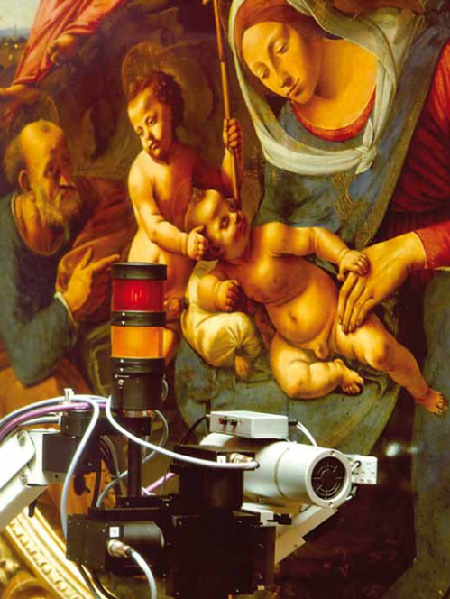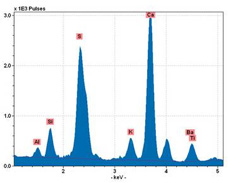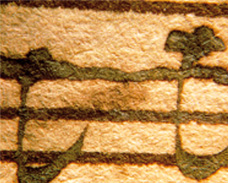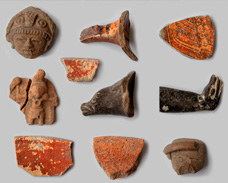Portable μ-XRF Spectrometer
Analyse Valuable and Stationary Objects On-Site
Bruker ARTAX is the first commercially available portable µ-XRF spectrometer, for analysis of unique and valuable objects on site, particularly in archaeometry and art history.
- Simultaneous multi-element analysis from Na(11) to U(92) with spatial resolution down to 70 µm.
- Non-destructive, non-contact analysis, with no damage whatsoever to the sample.
- Completely portable – ARTAX can be set up and in use within 30 minutes. A normal mains power supply is all that’s required.
- Choice of configurations to suit your application and budget.
Contact us for more information and quotes:
01223 422 269 or info@blue-scientific.com
Contact us

Example Applications

Analysing Pigments in an Historical Painting
The Bruker ARTAX portable μ-XRF spectrometer delivers spatially resolved element analysis of objects of art, directly on site. Non-destructively characterise differences within fine structures.
In this example, the painting “The Holy Family“ by Piero di Cosimo was analysed, to determine whether the blue pigments had discoloured or degraded in certain areas. The elemental composition was analysed, which confirmed that the discoloration of smalt and ultramarine was not attributed to what is known as “blue disease”. The analysis also suggested that changes in the painting due to degenerative effects of other pigments should be excluded, because of the material-technical evidence.
Watch videos from our workshop at the National Gallery: “Art Conservation with Micro-XRF”

Ink on Historical Manuscripts / Forensics
16th-18th century historical manuscripts were written using iron gall ink. The use of naturally occurring raw materials means that the ink contains varying amounts of its constituents and also contains contaminations. By analysing these components, ink can be characterised and manuscripts can be ordered chronologically.
This application example describes how the Bruker ARTAX µ-XRF spectrometer can be used to non-destructively analyse priceless originals. The same technique can be used to analyse forensic evidence in criminal investigations.
Characteristic XRF-spectra ‘fingerprints’ of various iron gall inks were acquired. This lead to characterisation and chronological classification of the inks used on the manuscript, which allows the date of the work to be determined.

Characterising Historic Pigments
By knowing when a historic pigment was first synthesised or used, the creation dates of paintings and other objects can be determined, and works of art can be put in chronological order.
In this example, two coloured prints of Albrecht Dürer’s copperplate “Peter and John heal the lame person” were analysed. The objective was to determine their chronological order by characterising the pigments. Using the ARTAX proved that one copy was coloured in the late 16th century by Georg Mack, while the colouration of the second print took place later, in the 19th century.

Determining the Provenance of Ceramics
Chemical characterisation of ceramics, for provenance and regional allocation, must be non-destructive. The Bruker ARTAX is a fast and reliable tool for provenance studies:
- Highly sensitive, with detection limits in the low ppm range
- Analyse up to a depth of 1 mm, for representative results from a small number of measurements
- Simple and reliable quantification, with negligible matrix effects
ARTAX delivers highly reproducibile results, with precise sample positioning and automatic line / area scan.
Watch videos from our workshop at the National Gallery: “Art Conservation with Micro-XRF”
Technical Details
The Bruker ARTAX consists of a compact measuring head containing:
- A specially designed, compact micro-focus X-ray tube with metal-ceramics technology.
- Polycapillary X-ray optics that produce a micro-spot of primary X-radiation with extremely high intensity.
- A compact, high resolution, nitrogen-free XFlash® SD detector with high speed/low noise electronics.
- An advanced sample viewing and analysis spot positioning system.
Convenient, Portable Tripod
The measuring head, motor-driven X-Y-Z positioning stage and control unit are seated on a mobile, vibration-damped tripod. This enables free positioning of the measuring system in relation to the sample, with reproducibility of better than ±10 µm.
Fast X-Ray Tube Exchange
The measuring head consists of a central unit containing the detector, the CCD camera and laser spot. The excitation unit, with tube housing, X-ray tube and X-ray optics, is mounted on the side, fixed by a precision lock for fast exchange. X-ray optics can be changed quickly, as well as excitation sources and target materials, to suit the sample being analysed.
Light Element Analysis
The ARTAX is equipped with a helium purging system for light element analysis. This extends the measurement range compared to ambient air, from Ti(22) to U(92) down to Na(11). Using helium instead of a vacuum protects the sample, which may not be vacuum-safe. Detect light elements including P(15), S(16) and Cl(17), as well as important elements that might otherwise go unnoticed, such as Al(13) and Si(14).
Additional Features
- Improved accessibility of samples due to the compact measuring head and distance from the sample.
- Touch sensor to avoid contact with the object.
- Improved radiation safety, with additional control terminal for direct access to basic functions
- Three safety contacts for additional warning lamps, door interlocks etc.
- Software controlled helium flow for light element detection, and software controlled laser spot positioning.

